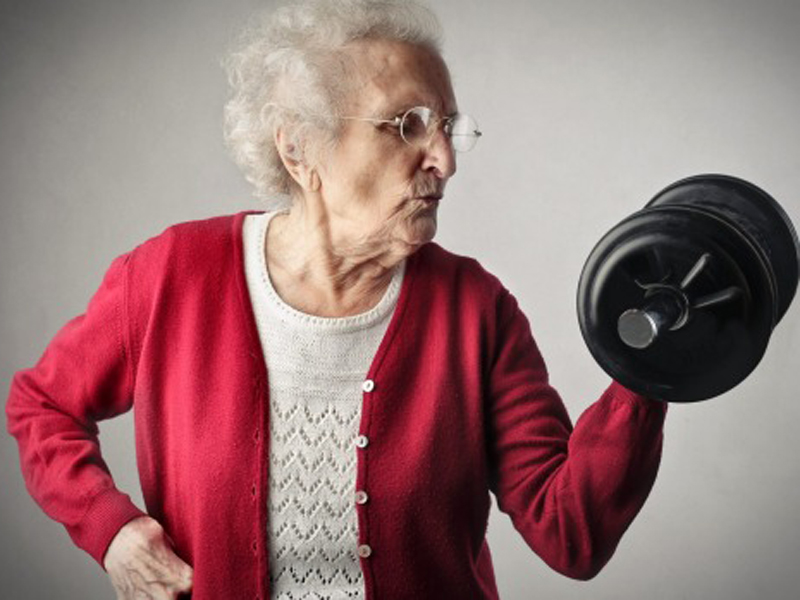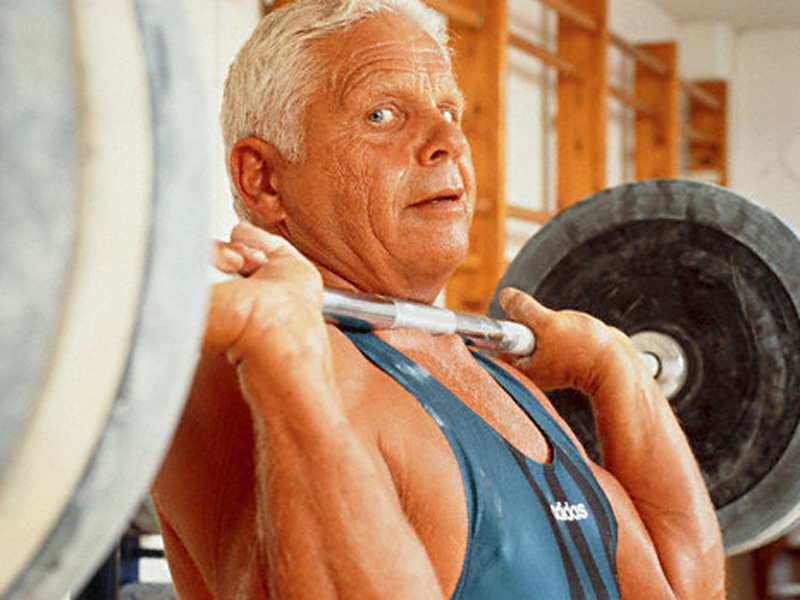Sarcopenia was labelled a disease last year – but could this draw the wrong kind of attention to the problem?
Sarcopenia was thrust into the spotlight by being named a disease last year – but could this draw the wrong kind of attention to the problem?
Wth its Greek linguistic roots, Sarcopenia sounds very serious. But the word was coined just decades ago and almost as a joke.
During the 1980s, US specialist Dr Irwin Rosenberg noticed something abnormal about many of his older patients. “He used to walk around hospitals as a gastroenterologist and lift up the sheets and see skinny little legs underneath,” recalls former colleague Professor Maria Fiatarone Singh, who is currently a geriatrician at the University of Sydney.
These patients were experiencing a devastating loss of muscle mass and function, which was associated with a greater risk of falls, frailty, admission to hospital, loss of independence, morbidity and death.
But at that time, there was no name for muscle wasting and the issue was often ignored. “Because it didn’t have a name nobody was actually dealing with it,” says Professor Fiatarone Singh. “[Rosenberg] said if we name it, maybe they’ll start treating it.”
At a conference in 1989, “[I] proposed somewhat jokingly that it might be necessary for there to be a Greek term for this condition, in parallel with osteoporosis and osteopenia in order that it be taken seriously,” says Dr Rosenberg, who now works at Tufts University in the US.
The term “sarcopenia” captures the Greek words “sarco”, meaning flesh or muscle, and “penia”, meaning loss. Estimates suggest that between five and 13% of people between 60 and 70 years of age have sarcopenia, while the prevalence ranges from 11 to 50% in people over 80, depending on the definition.
With a nine-fold increase in the number of Australians aged 85 and over in the last 50 years, “sarcopenia is huge, it’s going to get huger and we really have to do something about it,” says Professor Susan Kurrle, a geriatrician at the University of Sydney.
Since the creation of the word sarcopenia, an entire field of research into muscle loss in the elderly has opened up. Pharmaceutical companies have eyed sarcopenia as a potential market for new drugs, but their efforts have not yet paid off, says Professor Fiatarone Singh. “There isn’t a drug to treat sarcopenia and yet all that while there has been an intervention that is very effective for it, which is weight lifting exercise.”
Addressing sarcopenia would go some way towards lowering the rates of falls in the elderly, which accounted for 83,800 hospitalisations in Australia in 2009. It would also help reduce frailty in the elderly.
“And if a person is assessed as frail they are more likely to die, to go into hospital, to go into residential care, to need lots of services and just generally to get sick,” says Professor Kurrle.
The movement to increase awareness of sarcopenia culminated in its formal recognition as a disease last year. As of October 2016, sarcopenia was given its own code (M62.84) on the International Classification of Disease (ICD-10), which provides the international standard for diseases, disorders, injuries and other related health conditions.
While most countries automatically adopt this classification, Australia has a modified version (ICD-10AM). “So what we are working on now is getting the ICD-10AM in Australia for sarcopenia,” explains Professor Gustavo Duque, a geriatrician at the University of Melbourne who is leading the application process.

More than one definition
The major barrier in upgrading sarcopenia to a disease has been agreeing on a cut-off point. Muscle loss is a normal part of ageing: all adults lose approximately 1 to 2% of muscle each year past the age of 50. However, adults with sarcopenia lose so much muscle mass and strength that it affects their ability to perform normal daily activities, such as crossing the road or getting out of a chair.
But at what point does muscle loss become a disease? There is still no exact answer to this question. “The greatest challenge [for recognising sarcopenia] is perhaps the lack of standardisation and poor agreement between sarcopenia definitions,” says Professor Robin Daly, chair of exercise and ageing at the Institute for Physical Activity and Nutrition at Deakin University.
The most widely accepted definition, according to Professor Duque, is that provided by the European Working Group on Sarcopenia in Older People. This recommends diagnosing sarcopenia in patients with a walking speed below 0.8m/s over four metres and a low muscle mass determined using dual energy X-ray absorptiometry. Under this consensus definition, low muscle mass is defined as being below two standard deviations of the normal young mean (<7.23 kg/m2 and in women at <5.67 kg/m2). Sarcopenia can also be measured using handgrip strength, with thresholds of 20kg in women and 30kg in men.
The Working Group also breaks the disease down into three conceptual stages: presarcopenia, sarcopenia and severe sarcopenia.
“The cut-off point is still very much debated,” says Professor Kurrle. “[But] I think we’ve agreed … on 0.8m/s. If you can’t walk faster than 0.8m/s, which is pretty slow, then you can’t cross the road. You probably don’t walk very far at all and therefore your future does not look very good.”
A quick way to get an indication of muscle strength is to simply ask a patient to fold their arms and stand up from a chair, says Professor Kurrle. “It is a really good assessment of the strength of your quadriceps and hamstrings.”
The variety of definitions did not dissuade the ICD-10 committee from giving sarcopenia its own code. “There is a wide conceptual agreement on the base definition”, the ICD-10 coordination and maintenance committee stated.
Should sarcopenia be called a disease?
Some diseases are more obvious than others. Take pneumonia – that’s an easy disease to spot. It has a specific set of symptoms, a reasonably clear path to diagnosis and well-established treatments. When it comes to conditions that are closely related to ageing, such as sarcopenia, whacking on the “disease” label becomes contentious.
Professor Rachelle Buchbinder, the president of the Australian Rheumatology Association, argues against calling sarcopenia a disease, at least before the risks and benefits are well delineated. “It would be preferable to refer to age-related reduction in muscle and disuse to emphasise that the appropriate prevention … is increasing physical activity,” she says.
The problem with this approach is that patients, families and clinicians might “accidentally dismiss [sarcopenia] as just part of being old,” says Professor Renuka Visvanathan, a geriatrician at the University of Adelaide. “A common problem with things affecting older people is that … people over-attribute everything to ageing.”
But sarcopenia is not just normal ageing, according to Professor Duque. “Sarcopenia is more significant than the regular age-related muscle wasting,” he says.
He argues that sarcopenia is a disease, firstly, because it has measurable clinical outcomes, including the loss of functionality and the increased risk of falls.
And, secondly, because sarcopenia has distinct pathology, such as the loss of type two fibres in the muscle, replacement of muscle fibres with fat, an increase in fibrosis, changes in muscle metabolism, oxidative stress, and degeneration of the neuromuscular junction.
Sarcopenia has a number of suspected causes, including age-related decreases in hormone concentration (including growth hormone, testosterone, thyroid hormone and insulin-like growth factor), poor protein synthesis, reduction in motor nerve cells, genetic factors and early developmental influences.
But – like obesity and type 2 diabetes – it is largely aggravated by underactivity and poor nutrition, says Professor Fiatarone Singh.
“We’ve engineered high force exercise out of our lifestyle,” she says. “We have the ability to engineer that back into our lives, which would eliminate a good portion of loss of muscle function with ageing.”
Whenever a large number of people are classified as having a new disease, suspicions of disease mongering and overdiagnosis follow. But sarcopenia experts dismiss this idea. “I don’t know how people can say [the definition] is too broad or too low,” says Professor Visvanathan.
Creating a new disease could create the misconception that a pill is going to solve the problem.
The high prevalence of sarcopenia reflects the similarly high rates of chronic disease in older populations, argues Professor Fiatarone Singh. In 2004, obesity affected 37% of men and 10% of women over 75 in Australia, according to the Department of Health. Around one in three people aged over 85 have dementia, according to Alzheimer’s Australia. “So I don’t think it is out of the realm of other diseases that are common in older people,” says Professor Fiatarone Singh.
The dark side of fame
Earning the disease title certainly gives sarcopenia a higher profile, but this is a “double-edged sword”, according to Professor Fiatarone Singh.
“There are good and bad things about calling [sarcopenia] a disease,” says Professor Fiatarone Singh. On one hand, the new classification brings the problem of muscle wasting to the forefront of doctors’ minds.
“Now that it is defined as a disease, there should be greater interest … amongst clinicians in making a diagnosis of sarcopenia to identify those people at increased risk,” agrees Professor Daly.
On the other hand, creating a new disease could create the misconception that a pill is going to solve the problem, says Professor Fiatarone Singh. “I’m very firmly on the side of this not being something that a pill is going to fix,” she says.
Not only is exercise one of the only evidence-based treatments for sarcopenia, it also improves a number of other chronic conditions, such as diabetes, osteoporosis, dementia and depression.
Pharmaceutical companies – including Novartis and Eli Lilly – are “very interested” in sarcopenia and are currently working on new products, says Professor Duque. The whole initiative to get sarcopenia validated as a disease was partly to pique the interest of pharmaceutical companies and encourage the development of drugs to treat sarcopenia.
In the past, big pharma has looked into androgens and testosterone, and growth hormones for sarcopenia but there are no drugs being used to treat sarcopenia in Australia at present.
As well, labelling people as sick is known to be “detrimental in its own right” as it causes anxiety in patients, says Professor Buchbinder. “There are also concerns about the possibility of overdiagnosis and overtreatment,” she said. “I have no problem with recognising the problem but I would not want to see it overmedicalised.”
However, there are benefits that come with being a newly minted disease. If sarcopenia is added to the list of diseases in Australia it may attract a Medicare rebate, says Professor Fiatarone Singh.
“Presumably you could get a rebate for the treatment of that disease, which at this stage is weight-lifting exercise – also known as strength training or resistance training.”
Maybe older Australians at risk for sarcopenia could get their gym memberships and sessions with personal trainers subsidised? But, then again, that could be just wishful thinking.



